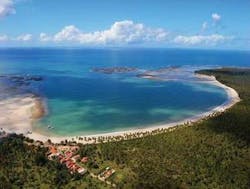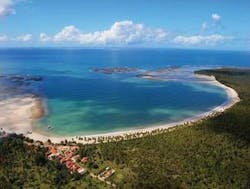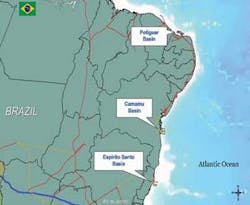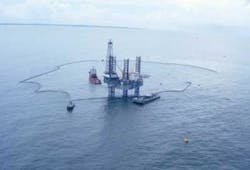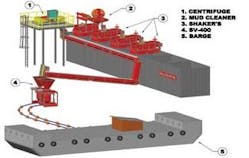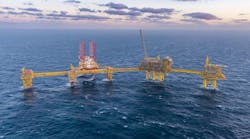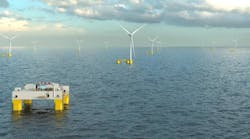Perry Morris - El Paso Oil & Gas
Keith Browning, Kevin Redfern - Halliburton
One key element of the El Paso Oil & Gas exploration program offshore Brazil during the recent drilling and completion of the Acai and Cacau exploration wells in the Camamu basin was to ensure compliance with a zero discharge policy. The wells were in a shallow 23 m (75.5 ft) water depth, near shore and 11 km (6.8 mi) from an extremely environmentally sensitive area. Brazilian authorities designated the coastal area as a future recreational development.
Equipment outlay
El Paso contracted Halliburton’s Baroid Surface Solutions services to provide equipment and personnel at the rig site to transport cuttings and drilling waste to a dedicated cuttings barge. To protect the delicate subsea reef environment and the nearby Camamu white sand beaches, El Paso installed booms completely surrounding theTodco 156 rig. The dedicated cuttings barge was moored outside the booms to allow access to the barge for dumping cuttings further out into deepwater. This configuration resulted in a greater distance than normal for cuttings transportation.
The distance from the rig to the barge, combined with distance needed to pump the cuttings across the rig’s main deck, down to sea level, across the water, and then up to the main deck storage tanks on the cuttings barge, meant that cuttings and waste had to be safely, efficiently, and reliably transported approximately 90 m (295 ft).
Drilling parameters
The wells were drilled with a KCl water-based mud (WBF) treated with a polymer for shale stabilization. The well design and drilling parameters dictated that the cuttings transportation system had to collect and transport the cuttings generated from all well intervals including the 26-in. and 17 ½-in. hole sections. In particular, these large hole diameter intervals were drilled at rates of penetration (ROP) reaching 60 ft/hr (~20 m/hr), consequently generating up to 20 cu m (125 bbl) of cuttings per hour.
The solids control system on the rig included the following:
- Three linear motion shakers
- One linear motion mud cleaner
- One 16/2 mud cleaner with 16 x 4-in. and 2 x 12-in. hydrocyclones
- One decanting centrifuge.
Equipment configuration
El Paso and Surface Solutions agreed on the equipment components and configuration after examining the drilling and operating parameters, plus the limited deck space on the rig. The final system was designed to transport cuttings efficiently and reliably while preserving as much rig deck space as possible.
Cuttings and mud were transported from the shale shakers to the SV 400 pumping units with an auger located underneath the discharge end of the shakers, via a vertical chute, into an inclined auger which carried mud and cuttings up to the dual gravity-feed hoppers mounted on top of the SV400 units. To improve system efficiency and while running casing, the team modified the auger inclination by decreasing from approximately 40º to an angle of less than 30º. This is the maximum angle of inclination used to convey very wet cuttings and or mud. The modification greatly improved operations and cuttings transport efficiency.
Also, in the event of inclement weather conditions causing problems with loading the cuttings barge, another modification installed a big bag cuttings fill station. This allowed drilled cuttings to be loaded by the inclined auger and stored until the barge returned to station, and consequently ensured no non-productive time.
Cuttings pumping unit
One key technology deployed for cuttings transfer was the SV 400 system. The unit is a compact, air-operated, vacuum recovery and positive pressure discharge cuttings pumping unit. Each unit can transport drilled cuttings and/or waste up to 200 m (650 ft), making it a good choice for the 90-m (295-ft) distance to the moored cuttings barge. Another advantage of the unit is that it is totally pneumatic and therefore needs no electrical power. As a result, it can be used in Zone 1 operations, with reduced safety/installation implications. It also can be used to clean pits, spills, drains, the pit room, the rig floor, and other areas around the rig and drill site.
The team acknowledged the system offers the flexibility of either suction or gravity feed, providing more installation options. Also, it sucks cuttings into the hopper, reducing the risk of bridging in the feed hopper.
The team installed two of these units side-by-side and used a gravity feed from an inclined 12-in. screw conveyor. Each unit used its own dedicated 4-in. delivery hose to the cuttings barge. This double delivery design was to provide 100% backup contingency in the event of the large cuttings forming a bridge inside a hose and or a potential problem with one of the units. An additional precaution was to connect the rig’s fire water supply system into the discharge hose manifold, which would be used to supply water should a bridge occur.
The team normally operated the unit in gravity mode, which meant the cuttings were pulled by a combination of gravity and vacuum directly into the pump discharge chambers through a knife gate valve. In this case and during periods of high ROPs or large amounts of sloughing shale returns over the shaker, the units were operated manually to reduce plugging potential. During periods of normal cuttings returns the units ran in automatic mode. The dual systems were able to handle the larger than expected size and quantities of sloughing shale and cuttings.
Cuttings transported
Once a timed amount of cuttings and mud was deposited into the chamber, the knife gate valve closed and the chamber was pressured up for discharge into a 4-in. hose which transported the cuttings in dense phase mode to the cuttings barge. The cuttings and mud then were deposited into storage tanks onboard the bargeCD ARPOADOR for future discharge into deeper water, where IBAMA (Brazilian Environmental Agency) permits the disposal of WBM drilled cuttings and drilling waste.
Based on barge tank tallies maintained throughout the drilling of both wells, the team calculated that 1,088 cu m (6,845 bbl) of cuttings, mud and rig waste were transported to the cuttings barge.
After some of the cuttings/rock generated were gathered, the team correlated the size and characteristics of these cuttings with the volumes generated and distance transported, which indicated a favorable performance of the units.
Considering the demanding operational and environmental conditions which resulted in long pumping distances, on and across the sea level, combined with the large volumes and the size of cuttings/rock produced, the technology provided the team with an efficient cuttings transfer operation in offshore Brazil. The team reported that the two wells were drilled and completed with all cuttings/waste materials transferred to the barge without incident or spill.
